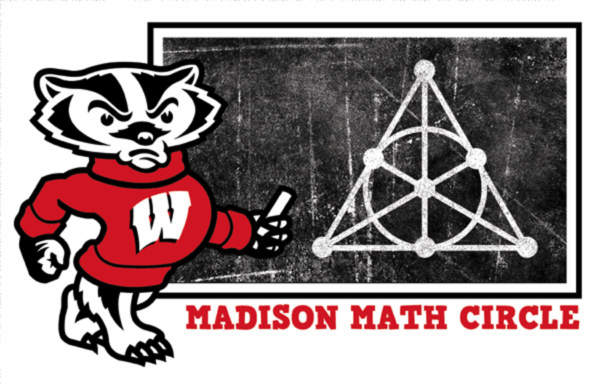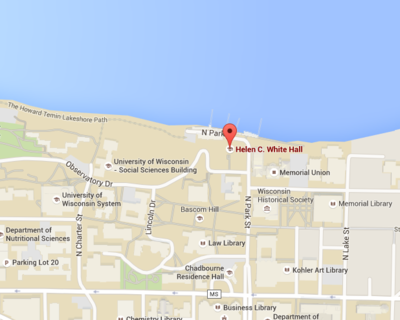Madison Math Circle
For the site in Spanish, visit Math Circle de Madison
COVID-19 Update
We are back to in person talks during the Fall 2021 semester.
As is the university's policy, all participants must wear masks. We will make every effort to maintain social distancing where possible.
What is a Math Circle?
The Madison Math Circle is a weekly series of mathematically based activities aimed at interested middle school and high school students. It is an outreach program organized by the UW Math Department. Our goal is to provide a taste of exciting ideas in math and science. In the past we've had talks about plasma and weather in outer space, video game graphics, and encryption. In the sessions, students (and parents) are often asked to explore problems on their own, with the presenter facilitating a discussion. The talks are independent of one another, so new students are welcome at any point.
The level of the audience varies quite widely, including a mix of middle school and high school students, and the speakers generally address this by considering subjects that will be interesting for a wide range of students.
After each talk we'll have pizza provided by the Mathematics Department, and students will have an opportunity to mingle and chat with the speaker and with other participants, to ask questions about some of the topics that have been discussed, and also about college, careers in science, etc.
The Madison Math Circle was featured in Wisconsin State Journal: check it out!
All right, I want to come!
We usually have a weekly meeting, Monday at 6pm in 3255 Helen C White Library, during the school year. New students are welcome at any point! There is no fee and the talks are independent of one another, so you can just show up any week, but we ask all participants to take a moment to register by following the link below:
Math Circle Registration Form
All of your information is kept private, and is only used by the Madison Math Circle organizer to help run the Circle.
If you are a student, we hope you will tell other interested students about these talks, and speak with your parents or with your teacher about organizing a car pool to the UW campus. If you are a parent or a teacher, we hope you'll tell your students about these talks and organize a car pool to the UW (all talks take place in 3255 Helen C White Library, on the UW-Madison campus, right next to the Memorial Union).
Meetings for Fall 2021
| Fall 2021 | ||
|---|---|---|
| Date | Speaker | Topic |
| September 20th | Daniel Erman | Number Games
We’ll play some math-based games and then try to understand some of the patterns we observe. |
| September 27th | Evan Sorensen | The fastest way to travel between two points
Given two points, we know the shortest distance between the points is a straight line. But is that always true? We will talk about how to build the best track for a toy car to travel between two points. We’ll start by trying a few different options together and having a race. We’ll then talk about how two brothers thought about how to solve this problem using interesting examples from physics. |
| October 4th | Yandi Wu | Do you wanna build a donut?
Topology is a field of math that deals with studying spaces. This math circle talk is an introduction to a concept in topology called “cut-and-paste” topology, which is named that way because we will build spaces out of cutting and gluing pieces of paper. |
| October 11th | Ivan Aidun | Words, Words, Words
We'll play a game where you have to guess a secret word that I choose. We'll figure out how to use logic to improve our guesses. Then, we'll explore some questions like: is there a best way to guess? or, what happens when I change the rules slightly? |
| October 18th | Allison Byars | Sheep and Wolves
In this math circle talk, we'll look at placing sheep and wolves on a grid so that none of the sheep get eaten. We'll find different arrangements and try to figure out the maximum number which can be placed on a board of given size and generalize it for an arbitrary board. We will also discuss how this relates to a field of mathematics called combinatorics. |
| October 25th | Jacob C Denson | Proofs in Three Bits or Less
How many questions does it take to beat someone at Guess Who? How long should it take for you to figure out how to get to this math talk from your house? How many questions do you have to ask your classmate before you know they're telling the truth to you? Let's eat some pizza, and talk about how mathematicians might reason about these problems. |
| November 1st | Qin Li | How do we describe the world?
The physical world consists of everything from small systems of a few atoms to large systems of billions of billions of molecules. Mathematicians use different languages and equations to describe large and small systems. Question is: How does mother nature use different languages for different systems and scales? Let us see what these languages look like, talk about their connections and differences, and see how they are reflected in our day-to-day life. |
| November 8th | John Yin | River Crossings
Here's a classic puzzle: A farmer needs to move a wolf, a sheep, and a box of cabbages across a river. He has a boat that can fit only one object other than himself. However, when left alone, the wolf will eat the sheep, and the sheep will eat the cabbages. How can the farmer move the wolf, the sheep, and the box of cabbages across the river without anything being eaten? I will discuss this problem by connecting it to graph theory, then give a generalization. |
| November 15th | Erik Bates | How big is a cartographer’s crayon box?
Have a look at a world map. If you are looking at one with borders and colors, notice that no border has the same color on both sides. That is, no neighboring countries are colored the same. So how many different colors are needed to make this possible? Does the answer change for a map of the U.S., when we try to color its fifty states? What about a map of Wisconsin with its 72 counties? We will explore these questions---and uncover some very deep mathematics---by doing the simplest and most soothing activity: coloring. |
| November 22nd | Robert Walker | TBA |
Directions and parking
Our meetings are held on the 3rd floor of Helen C. White Hall in room 3255.
Parking. Parking on campus is rather limited. Here is as list of some options:
- There is a parking garage in the basement of Helen C. White, with an hourly rate. Enter from Park Street.
- A 0.5 mile walk to Helen C. White Hall via these directions, many spots (free starting 4:30pm) in Lot 26 along Observatory Drive.
- A 0.3 mile walk to Helen C. White Hall via these directions, many spots (free starting 4:30pm) in Lot 34.
- A 0.3 mile walk to Helen C. White Hall via these directions, 2 metered spots (25 minute max) in front of Lathrop Hall.
- A 0.2 mile walk to Helen C. White Hall via these directions 6 metered spots (25 minute max) around the loop in front of Chadbourne Hall .
- For more information, see the UW-Madison Parking Info website.
Email list
The best way to keep up to date with the what is going is by signing up for our email list. Please add your email in the form: Join Email List
Contact the organizers
The Madison Math Circle is organized by a group of professors and graduate students from the Department of Mathematics at the UW-Madison. If you have any questions, suggestions for topics, or so on, just email the organizers here. We are always interested in feedback!
and Caitlin Davis, Connor Simpson, and Ivan Aidun.
Donations
Please consider donating to the Madison Math Circle. Our main costs consist of pizza and occasional supplies for the speakers. So far our costs have been covered by donations from the UW Mathematics Department as well as a generous gifts from private donors. The easiest way to donate is to go to the link:
There are instructions on that page for donating to the Math Department. Be sure and add a Gift Note saying that the donation is intended for the "Madison Math Circle"! The money goes into the Mathematics Department Annual Fund and is routed through the University of Wisconsin Foundation, which is convenient for record-keeping, etc.
Alternately, you can bring a check to one of the Math Circle Meetings. If you write a check, be sure to make it payable to the "WFAA" and add the note "Math Circle Donation" on the check.
Or you can make donations in cash, and we'll give you a receipt.
Help us grow!
If you like Math Circle, please help us continue to grow! Students, parents, and teachers can help by:
- Like our Facebook Page and share our events with others!
- Posting our flyer at schools or anywhere that might have interested students.
- Discussing the Math Circle with students, parents, teachers, administrators, and others.
- Making an announcement about Math Circle at PTO meetings.
- Donating to Math Circle.
Contact the organizers if you have questions or your own ideas about how to help out.
Useful Resources
Archived Abstracts
2015 - 2016 Math Circle Page (Spanish)
Link for presenters (in progress)
Advice For Math Circle Presenters
Sample Talk Ideas/Problems from Tom Davis








